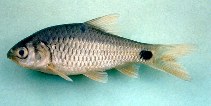| Family: |
Cyprinidae (Minnows or carps), subfamily: Smiliogastrinae |
| Max. size: |
20 cm SL (male/unsexed) |
| Environment: |
benthopelagic; freshwater; pH range: 6 - 6.5; dH range: 12 |
| Distribution: |
Asia: Myanmar (Ref. 4832) and from Mekong of Thailand through Indonesia (Ref. 12693). |
| Diagnosis: |
Dorsal spines (total): 4-4; Dorsal soft rays (total): 8-8; Anal spines: 3-3; Anal soft rays: 5-5. Lateral line complete; 4 1/2 scales between lateral line and dorsal fin origin; four barbels; last simple dorsal ray bony and serrated behind; one large blotch at anterior base of dorsal fin and a round spot in the middle of caudal peduncle. Juveniles and sometimes adults possess 2-4 midlateral round to elongate spots (Ref. 7050). Color in life varies from silvery gray to greenish gray; darker dorsally; paler or nearly white on throat and belly; a bar behind operculum on shoulder; body markings (spots or band) may be absent on large specimens, except spot on caudal base. 8-9 scales from nape to dorsal; 2.5 (rarely 3) scales between ventral and lateral line. 4th dorsal spine serrate. Round, broad-tipped snout equal or a seventh longer than eye (Ref. 2929). |
| Biology: |
Occurs from sea level to at least 2000 m above sea level and is commonly found below waterfalls in isolated mountain streams and on small islands inhabited by few other freshwater fishes (Ref. 2091). Inhabits medium to large rivers, stagnant water bodies including sluggish flowing canals and brooks of the middle Mekong (Ref. 12975). Found in middle to bottom depths in fairly shallow waters where it feeds on zooplankton, insect larvae and some vascular plants. Probably does not migrate (Ref. 12693). |
| IUCN Red List Status: |
Least Concern (LC); Date assessed: 31 January 2019 Ref. (130435)
|
| Threat to humans: |
harmless |
Source and more info: www.fishbase.org. For personal, classroom, and other internal use only. Not for publication.

